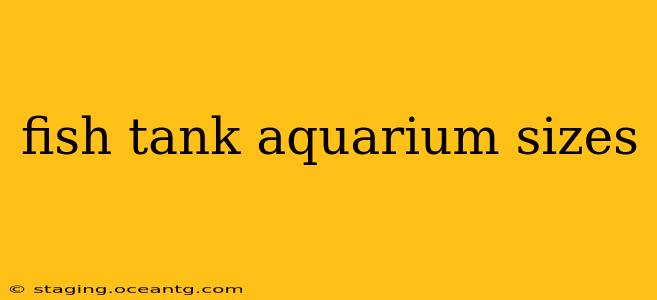Choosing the right fish tank size is crucial for the health and happiness of your aquatic pets. A tank that's too small can lead to stress, disease, and ultimately, the death of your fish. Conversely, a tank that's too large can be difficult to manage and maintain. This guide will delve into the various sizes available, helping you select the perfect aquarium for your needs and the needs of your finned friends.
What are the standard sizes of fish tanks?
Fish tanks come in a wide variety of sizes, from small nano tanks ideal for beginners and smaller spaces to massive, show-stopping aquariums. Standard sizes are often expressed in gallons (US gallons, unless otherwise specified), but you might also see them listed in liters. Common sizes include:
- Small Tanks (under 10 gallons): These are often suitable for smaller fish like bettas, shrimp, or snails, but they require careful consideration of stocking levels and filtration. Overstocking a small tank is extremely detrimental to the water quality and the fish's health.
- Medium Tanks (10-20 gallons): This size allows for a wider range of fish and invertebrates. You can still house smaller species in larger numbers, or introduce a few larger, less active fish.
- Large Tanks (20-55 gallons): These provide ample space for a diverse community tank with various species, plants, and decorations. Maintenance is more involved, but the benefits for your fish outweigh the extra effort.
- Extra-Large Tanks (55+ gallons): These are often found in dedicated hobbyists' homes or public aquariums. They allow for more complex ecosystems and larger, more active fish. Specialized equipment and significant upkeep are necessary.
It's important to remember that these are just general guidelines. The actual number of fish you can keep depends on several factors beyond tank size alone, such as the fish's size, activity level, and waste production.
What size tank do I need for a betta fish?
While some claim a 5-gallon tank is sufficient for a betta, experts generally recommend at least a 5-gallon tank, and preferably larger (10 gallons or more). Bettas require good water quality, and a larger tank allows for better water parameter stability. The extra space also provides opportunities for enrichment, such as hiding places and floating plants. Think of it as providing a better quality of life for your betta—they're more than just tiny fish in a bowl!
How many gallons is a 20 inch long tank?
The gallonage of a tank isn't solely determined by length. You need the length, width, and height to calculate the volume accurately. A 20-inch long tank could be anywhere from a few gallons to over 20 gallons depending on its other dimensions. Use an online aquarium calculator to determine the volume in gallons based on its exact dimensions.
How many fish can I put in a 20 gallon tank?
The number of fish suitable for a 20-gallon tank depends heavily on the size and species of fish. A general rule of thumb is the "one-inch-per-gallon" rule, but this is an oversimplification and often leads to overstocking. Consider the adult size of the fish, their activity levels, and waste production. Smaller, less active fish can be kept in slightly higher numbers than larger, more active fish. Researching the specific requirements of the species you intend to keep is paramount. It's always better to understock a tank than overstock it.
What is the best size fish tank for beginners?
For beginners, a 10-20 gallon tank is a good starting point. This size is manageable in terms of maintenance and allows for a relatively diverse community of fish. It's large enough to maintain reasonable water quality, but not so large as to be overwhelming. Start with hardy, beginner-friendly fish species and research their specific needs before introducing them to your aquarium.
Conclusion
Selecting the appropriate fish tank size is a critical step in responsible fishkeeping. By carefully considering the needs of your chosen fish species and utilizing online resources, you can choose a tank that provides a thriving environment for your aquatic companions. Remember, a well-planned and appropriately sized aquarium will bring you years of enjoyment while ensuring your fish are healthy and happy.
